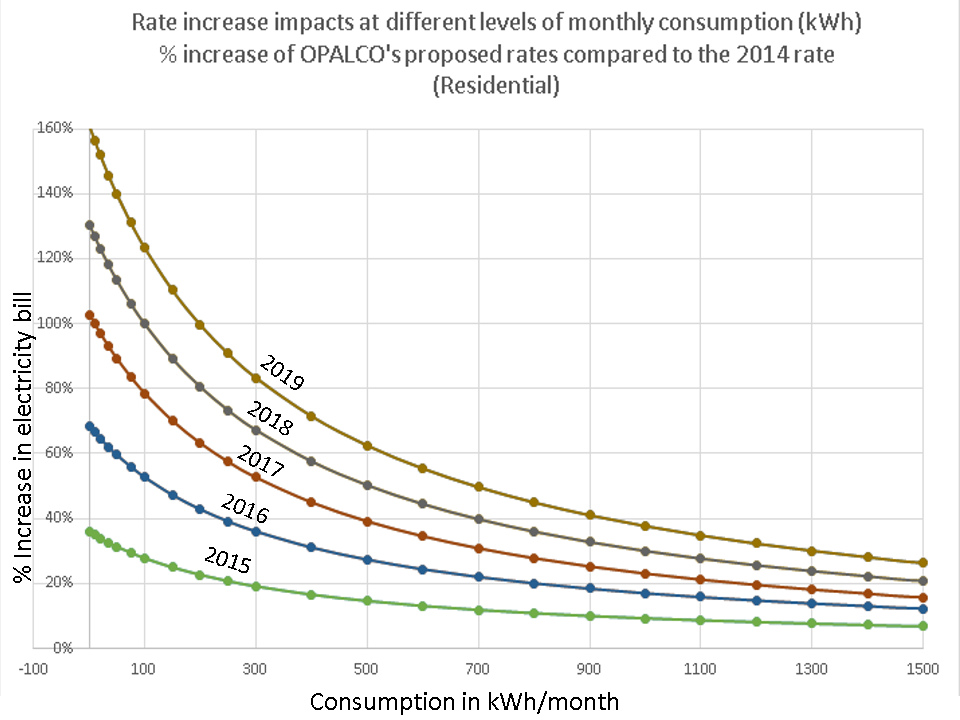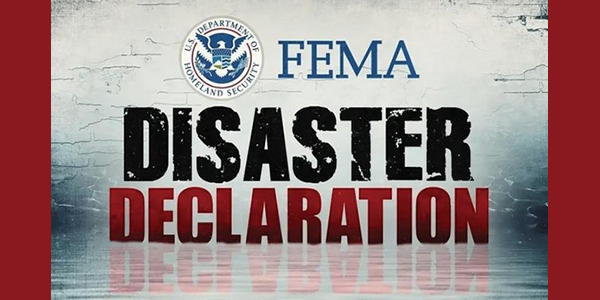— by Chom Graecen —
Be warned. Some of us, particularly small electricity users, might be in for an electrifying shock treatment. Electricity prices are going up to the point where some may no long be able to afford this supposedly basic necessity.
Despite OPALCO’s effort to educate its members about the recent electricity rate hike, not many may realize the full implication of the OPALCO’s January 2015 board decision.
The board approved a 12% rate increase across the board starting February 2015. The 12% increase is to be followed by four more increases at 6% each year in the next four years. This means a combined 41% increase by 2019, on top of past rate hikes. It is debatable whether a 41% increase in electricity rates by 2019 is justified. Even if the proposed massive rise was warranted, there is still the issue of cost allocation and affordability.
The rate impact does not fall on all members equally. In an attempt to recover more fixed costs by increasing the monthly charge (“facility charge”), small users are disproportionately affected by the newly approved rate structure. As shown in the graphic, small users may see as much as 160% increase in electricity bills by 2019. In comparison, an average resident, with monthly consumption of around 1,000 kilowatt-hours, will see a 38% rise, while the increase for larger users will be even less.
Though some small users may be well-off owners of vacation homes, others are low-income households living on a tight budget or environmentally conscious individuals who try to live with a small footprint, or both.
OPALCO board may have good intentions but their approved tariff structure has two undesirable consequences: 1) giving a disincentive for people to conserve energy (the more you use, the cheaper the total per unit cost of electricity is); and 2) electricity becoming unaffordable for low-income population in the county.
The volunteer-based program “Project PAL” provides some assistance but is hardly adequate. The $150 assistance per year from Project PAL pales in comparison to the increase of $589 in fixed charges alone in 2019. And Project PAL can assist only 279 households, about a quarter of eligible low-income households.
What is being questioned here is not the merit of Project PAL but rather the priorities and direction set by the OPALCO board. Is the board doing enough to ensure affordability for its members-owners? Is affordable electricity service not an important objective of OPALCO? Is OPALCO prioritizing provision of broadband over provision of affordable electricity for all?
These are a set of important questions for all of us members-owners to ask OPALCO board of directors. This article deals with affordability and rates. Future articles will raise other issues, such as broadband and risks as the OPALCO election approaches.
This year, two director positions from Orcas are open. Two candidates Randy Cornelius (recently retired General Manager of OPALCO) and Ed Sutton (chosen by OPALCO search committee) are running against the two incumbents, Winnie Adams and Chris Thomerson. The voting is closed on May 2, 2015.
**If you are reading theOrcasonian for free, thank your fellow islanders. If you would like to support theOrcasonian CLICK HERE to set your modestly-priced, voluntary subscription. Otherwise, no worries; we’re happy to share with you.**









The new OPALCO rate structure and subsequent rate increases are a significant impact on this generation of co-op members no matter how you slice it. We are carrying the financial burden of the future sustainability of power to our island communities as we fund major capital expenses to maintain our infrastructure over the next several decades. Chom raises important issues but misses the mark in some of her assumptions.
Chom asks, “Is the board doing enough to ensure affordability for its members-owners? Is affordable electricity service not an important objective of OPALCO?”
Affordability is one of many factors OPALCO Leadership must consider in setting policies and rates. Read the most recent strategic directives (Jan 2015, available online) to get the full list, but in short affordability must be balanced with safety, incentives for energy efficiency, conservation and local distributed power programs and, especially key in this climate of change, revenue and financial stability.
During the budgeting process, the OPALCO leadership and Board considered the impact of the rate increase on vulnerable members and injected $25,000 into the 2015 budget for Project PAL (normally member funded) to help bridge the gap. Chom’s assertion that PAL can only assist a small portion of members in need is false. PAL can assist as many members as member donations support. If you feel strongly that low income, senior and disabled members deserve a break, please donate to Project PAL. A needs assessment is underway this year to accurately understand member demand for PAL funds and retool the program as necessary to meet the need.
In addition to PAL, OPALCO is supporting our membership with home efficiency audits and retrofits, cooperating with LIHEAP and the Opportunity Council to match members in need with available resources. Since 2008, OPALCO has provided $1,983,492 in rebates and retrofits for our members, making a significant positive impact on the efficiency and energy-affordability of island homes.
Chom questions the parity of the new rate structure. In fact, the distribution of costs is now more equitably shared and is based on an extensive cost-of-service study. For example, in the previous rate structure, seasonal members’ part-time use of our full-time system was subsidized by all members. Chom cries foul when frugal energy users, such as her family, who have already made their investments and received their rebates do not continue to get rewarded. This is an issue to be addressed through Energy Savings programs and not rates. OPALCO admires and appreciates the contributions of frugal energy users who help to minimize our demand for power and our carbon impact. That appreciation, however, cannot be expressed on the backs of all rate payers.
All members must pay their fair share to cover the fixed costs to operate and maintain our electric cooperative regardless of usage, including those who have the privilege to own renewable generation or who use less energy through efficiency investments. And let’s not confuse this issue with our voluntary member-funded programs, such as PAL.
Chom asks “Is OPALCO prioritizing provision of broadband over provision of affordable electricity for all?”
The answer is no. Providing electricity is our core business. The construction and maintenance of our fiber grid control backbone is the foundation of our automated electrical distribution system. With the establishment of Rock Island Communications as a wholly owned subsidiary, we can make that member-owned infrastructure available for a small short-term investment to those who need it and in return get a revenue stream projected to give our Co-op membership significant help in paying for the looming submarine cable replacements outside of rates.
The major capital expenses Suzanne Olson mentions above include the forthcoming $15 million Lopez to San Juan submarine cable replacement project. For those that want to learn more about that, see this video: https://www.youtube.com/watch?v=fT-fj-_ha_Y&feature=youtu.be
The underwater footage of the old cable is fascinating. It was filmed during the time OPALCO was helping the community recover from the CenturyLink submarine fiber cable failure, in 2013. A problem was found. We want to fix that.
For the record, the rebates and retrofits are funded by BPA. This is not money paid by OPALCO.
For all the truth and explanations of the commenters above, we should not lose sight of Chom’s excellently presented point: the allocation of the rate structure falls too heavily on the poor and those trying hardest to meet OPALCO’s supposed goal of energy conservation. There should instead be a tiered approach in the opposite direction, with large users, residential or commercial, bearing a proportionately higher rate of increase instead of smaller.
The just adopted rate structure for OPALCO’s future feels more like the Republican right than the San Juan’s center. All around us the “market approach” (ie. subsidies for the rich while the poor get to duke it out in the marketplace) raises the costs of education on the future generations, takes food and housing from the poor, decreases the availability of affordable housing. This is not a necessity; this is a choice – and the wrong choice for these islands.